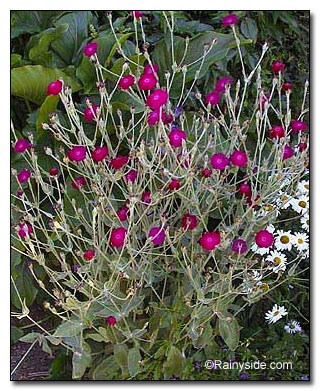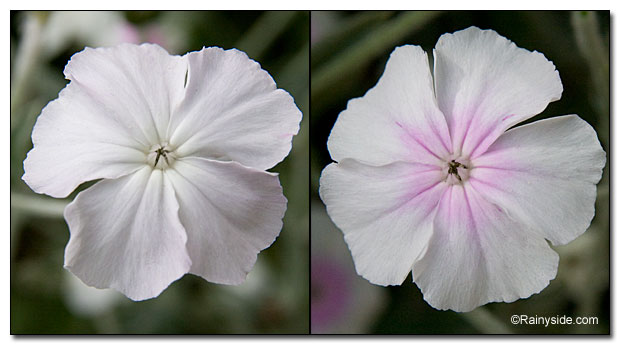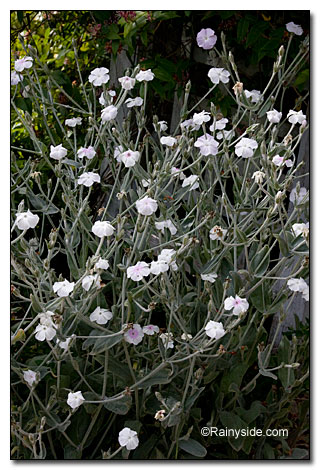Lychnis coronaria
ROSE CAMPION, DUSTY MILLER, CROWN-PINK, MULLEIN PINK, LAMP FLOWER
syn. Agrostemma coronaria, Campion rosea alba
Family: Caryophyllaceae
Pronounced: LIK-nis ko-ro-NAH-ree-uh
Quick Jumps
Growing Guide
Rainy Side Notes
GROWING GUIDE

Origin:
South-eastern Europe.
Plant Group:
Biennial, short-lived perennial.
Hardiness:
Sunset zones: 1-9, 14-24.
USDA zones: 3-8.
Heat zones: 8-1.
Mature size:
Height: 32 inches (80 cm).
Width 18 inches (45 cm).
Flowering period:
Late summer.
Flowering attributes:
Cymes of slightly reflexed purple to purple-red round flowers on long stalks.
Leaf attributes:
Silvery-gray, lance-shaped, woolly leaves that are soft to the touch.
Growth habit:
Biennial or short-lived perennial.
Light:
Full sun to partial shade.
Soil:
Fertile, humus rich, well-drained soil is best, but they grow in clay soil that is perpetually soggy in winter.
Feeding:
Add a complete organic fertilizer when planting.
Propagation Methods:
Sow seed as soon as ripe or in spring 60-65°F (15-18°C). These will self-seed quite freely, so once planted there should be a steady supply of volunteers.
Pruning Methods:
Dead head spent flowers to keep the plant flowering.
Rainy Side Notes


The campion white
Above the grass
Her lamp doth light
Where fairies pass.
Softly they show
The secret way
Unflickering glow
For elf and fay...
Excerpt from the poem “The Lamp Flower”, by Margaret Cecilia Furse.
The thick woolly leaves of this species were once used as lamp wicks, which contributed to its Genus name—Lychnis—from the Greek word, lychnos, meaning lamp. In addition, the bright pink-red flowers glowed like flames of fire. Because the lively blossoms of the species flowered on his feast day, Christians dedicated the plant to John the Baptist. They were reminded of the Bible verse—Luke 1:79—"to give light to those who sit in darkness and in the shadow of death, to guide our feet into the way of peace." It is believed the epithet coronaria, comes from its meaning crown; however, it could be a derivative of the French word, campagne, which means country.
This species is an old favorite of gardeners; even Thomas Jefferson grew them in his gardens, and gave the earliest American citation of the plant in 1767. A drift of these silvery species crowned with neon jewels are not suitable in a pastel themed landscape. In his book, "Garden Flowers", Christopher Lloyd dared his readers to "… allow the magenta-flowered Lychnis coronaria to seed itself around a colony" of Crocosmia 'Lucifer'. I haven't taken the dare myself, but can visualize a festival of fiery attention grabbers wildly dancing for our appreciation.
Although Lloyd had no use for pastel variations of L. coronaria, he thought the white campion (Lychnis 'Alba') was a great choice for a pastel and white garden. However, Louise Beebe Wilder had a different idea when he wrote it was "fine but far less beautiful." Me? I prefer the snowy white blossoms on silvery stems in my garden, and admire the fiery jewel-toned species in other people's landscapes. I planted it only once, when I first moved into my home before the turn of the century. It seeds true every year, because I don't grow another species in the garden for it to cross with. Hence, L. 'Alba' usually seeds true with white flowers. Another variety, L. 'Angel's Blush' has pink centers, and sometimes my white campion will show signs of pink centers, which looks similar to L. 'Angel's Blush'.
Considered a perennial, many gardeners treat it as a short-lived perennial or biennial. In my garden, these plants thrive on benign neglect; they seed themselves into areas that receive little to no supplemental watering or fertilizers. Allan Armitage noted in "Herbaceous Perennial Plants" that in northern areas the flowers were brighter, because our night temperatures are much cooler than in his southern location. The plant makes excellent scaffolding for sprawling Clematis recta.
Lychnis coronaria is a first-rate cut flower. Harvest the stems when one or two flowers are open, or pull the entire plant up and strip the foliage off. The flowers will last between five to seven days in a vase.
Debbie Teashon
Top image was photographed in unknown location; all others were photographed in author's garden.

Gardening for the Homebrewer: Grow and Process Plants for Making Beer, Wine, Gruit, Cider, Perry, and More
By co-authors Debbie Teashon (Rainy Side Gardeners) and Wendy Tweton
Copyright Notice | Home | Search | Annuals

